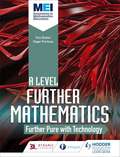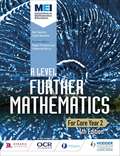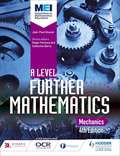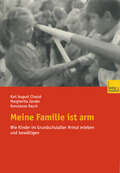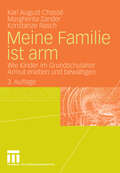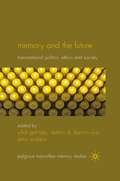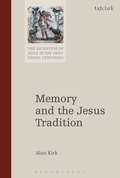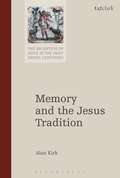- Table View
- List View
MEI Further Maths: Extra Pure Maths
by David BedfordDevelop a deeper understanding of mathematical concepts and their applications with new and updated editions from our bestselling series.- Build connections between topics using real-world contexts that develop mathematical modelling skills, thus providing your students with a fuller and more coherent understanding of mathematical concepts.- Develop fluency in problem-solving, proof and modelling with plenty of questions and well-structured exercises.- Overcome misconceptions and develop mathematical insight with annotated worked examples.- Enhance understanding and map your progress with graduated exercises that support you at every stage of your learning.
MEI Further Maths: Further Pure Maths with Technology
by Tom ButtonDevelop a deeper understanding of mathematical concepts and their applications with new and updated editions from our bestselling series.- Build connections between topics using real-world contexts that develop mathematical modelling skills, thus providing your students with a fuller and more coherent understanding of mathematical concepts.- Develop fluency in problem-solving, proof and modelling with plenty of questions and well-structured exercises.- Overcome misconceptions and develop mathematical insight with annotated worked examples.- Enhance understanding and map your progress with graduated exercises that support you at every stage of your learning.
MEI Further Maths: Numerical Methods
by Richard LissamanDevelop a deeper understanding of mathematical concepts and their applications with new and updated editions from our bestselling series.- Build connections between topics using real-world contexts that develop mathematical modelling skills, thus providing your students with a fuller and more coherent understanding of mathematical concepts.- Develop fluency in problem-solving, proof and modelling with plenty of questions and well-structured exercises.- Overcome misconceptions and develop mathematical insight with annotated worked examples.- Enhance understanding and map your progress with graduated exercises that support you at every stage of your learning.
MEI A Level Further Mathematics Core Year 1 (AS) 4th Ed (PDF)
by Ben Sparks Claire BaldwinExam Board: MEI Level: A-level Subject: Mathematics First Teaching: September 2017 First Exam: June 2018 An OCR endorsed textbook Help students to develop their knowledge and apply their reasoning to mathematical problems with textbooks that draw on the well-known MEI (Mathematics in Education and Industry) series, updated and tailored to the 2017 OCR (MEI) specification and developed by subject experts and MEI. - Ensure targeted development of reasoning and problem-solving skills with plenty of practice questions and structured exercises that build mathematical skills and techniques. - Build connections between topics, using real-world contexts to help develop mathematical modelling skills, thus providing a fuller and more coherent understanding of mathematical concepts. - Address the new statistics requirements with five dedicated statistics chapters and questions around the use of large data sets. - Help students to overcome misconceptions and develop insight into problem solving with annotated worked examples. - Develop understanding and measure progress with graduated exercises that support students at every stage of their learning. - Provide clear paths of progression that combine pure and applied maths into a coherent whole.
MEI A Level Further Mathematics Core Year 2 4th Edition
by Ben Sparks Claire BaldwinExam Board: MEILevel: A-levelSubject: MathematicsFirst Teaching: September 2018First Exam: June 2019An OCR endorsed textbookHelp students to develop their knowledge and apply their reasoning to mathematical problems with textbooks that draw on the well-known MEI (Mathematics in Education and Industry) series, updated and tailored to the 2017 OCR (MEI) specification and developed by subject experts and MEI.- Ensure targeted development of reasoning and problem-solving skills with plenty of practice questions and structured exercises that build mathematical skills and techniques.- Build connections between topics, using real-world contexts to help develop mathematical modelling skills, thus providing a fuller and more coherent understanding of mathematical concepts.- Address the new statistics requirements with five dedicated statistics chapters and questions around the use of large data sets. - Help students to overcome misconceptions and develop insight into problem solving with annotated worked examples.- Develop understanding and measure progress with graduated exercises that support students at every stage of their learning.- Provide clear paths of progression that combine pure and applied maths into a coherent whole.- Reinforce Year 1 content with short review chapters - Core FM Year 2 only.
MEI A Level Further Mathematics Mechanics 4th Edition (PDF)
by Jean-Paul MuscatExam Board: MEI Level: A-level Subject: Mathematics First Teaching: September 2017 First Exam: June 2018 An OCR endorsed textbook Help students to develop their knowledge and apply their reasoning to mathematical problems with textbooks that draw on the well-known MEI (Mathematics in Education and Industry) series, updated and tailored to the 2017 OCR (MEI) specification and developed by subject experts and MEI. - Ensure targeted development of reasoning and problem-solving skills with plenty of practice questions and structured exercises that build mathematical skills and techniques. - Build connections between topics, using real-world contexts to help develop mathematical modelling skills, thus providing a fuller and more coherent understanding of mathematical concepts. - Help students to overcome misconceptions and develop insight into problem solving with annotated worked examples. - Develop understanding and measure progress with graduated exercises that support students at every stage of their learning. - Provide clear paths of progression that combine pure and applied maths into a coherent whole.
MEI A Level Mathematics Year 1 (AS) 4th Edition (PDF)
by Sophie Goldie Cath Moore Val Hanrahan Jean-Paul Muscat Susan WhitehouseEncourage every student to develop a deeper understanding of mathematical concepts and their applications with textbooks that draw on the well-known MEI (Mathematics in Education and Industry) series, updated and tailored to the 2017 OCR (MEI) specification and developed by subject experts and MEI. - Develop problem-solving, proof and modelling skills with plenty of questions and well-structured exercises that build skills and mathematical techniques. - Build connections between topics, using real-world contexts to help develop mathematical modelling skills, thus providing a fuller and more coherent understanding of mathematical concepts. - Prepare students for assessment with practice questions written by subject experts. - Ensure coverage of the new statistics requirements with five dedicated statistics chapters and questions around the use of large data sets. - Supports the use of technology with a variety of questions based around the use of spreadsheets, graphing software and graphing calculators. - Provide clear paths of progression that combine pure and applied maths into a coherent whole.
Meine Familie ist arm: Wie Kinder im Grundschulalter Armut erleben und bewältigen
by Karl August Chassé Margherita Zander Konstanze RaschIm Buch wird aus Schilderungen von Kindern deutlich, wie sie sich, ihre Familie, ihr Umfeld unter Armutsbedingungen sehen. Eine einzigartige Analyse der verheerenden, vielschichtigen Auswirkungen von Armut auf Kinder. Das Buch liefert die Ergebnisse einer qualitativen Studie, die die Lebenslage von Kindern im Grundschulalter aus der Perspektive der Kinder untersucht. Es handelt sich um eine der ersten Studien, die auf Eigenaussagen der Kinder basiert. Insgesamt zeigt sich, dass die Prozesse zunehmender Benachteiligung und des mehrdimensionalen Ausschlusses von Kindern eine theoretische, empirische und konzeptuelle Herausforderung für die Soziale Arbeit darstellen. Es wird vor allem das bislang unzureichende Instrumentarium der Kinder- und Jugendhilfe deutlich. Im Ergebnis diskutiert das Buch Vorschläge für eine konzeptionelle Umorientierung der Jugendhilfe, womit ein nachvollziehbarer Transfer der Ergebnisse in den Bereich der sozialpädagogischen, erzieherischen und bildungsrelevanten Berufe erfolgt.
Meine Familie ist arm: Wie Kinder im Grundschulalter Armut erleben und bewältigen
by Karl August Chassé Margherita Zander Konstanze RaschIm Buch wird aus Schilderungen von Kindern deutlich, wie sie sich, ihre Familie, ihr Umfeld unter Armutsbedingungen sehen. Eine einzigartige Analyse der verheerenden, vielschichtigen Auswirkungen von Armut auf Kinder. Das Buch liefert die Ergebnisse einer qualitativen Studie, die die Lebenslage von Kindern im Grundschulalter aus der Perspektive der Kinder untersucht. Es handelt sich um eine der ersten Studien, die auf Eigenaussagen der Kinder basiert. Insgesamt zeigt sich, dass die Prozesse zunehmender Benachteiligung und des mehrdimensionalen Ausschlusses von Kindern eine theoretische, empirische und konzeptuelle Herausforderung für die Soziale Arbeit darstellen. Es wird vor allem das bislang unzureichende Instrumentarium der Kinder- und Jugendhilfe deutlich. Im Ergebnis diskutiert das Buch Vorschläge für eine konzeptionelle Umorientierung der Jugendhilfe, womit ein nachvollziehbarer Transfer der Ergebnisse in den Bereich der sozialpädagogischen, erzieherischen und bildungsrelevanten Berufe erfolgt.
Meine Familie ist arm: Wie Kinder im Grundschulalter Armut erleben und bewältigen
by Karl-August Chassé Margherita Zander Konstanze RaschIm Buch wird aus Schilderungen von Kindern deutlich, wie sie sich, ihre Familie, ihr Umfeld unter Armutsbedingungen sehen. Eine einzigartige Analyse der verheerenden, vielschichtigen Auswirkungen von Armut auf Kinder. Das Buch liefert die Ergebnisse einer qualitativen Studie, die die Lebenslage von Kindern im Grundschulalter aus der Perspektive der Kinder untersucht. Es handelt sich um eine der ersten Studien, die auf Eigenaussagen der Kinder basiert. Insgesamt zeigt sich, dass die Prozesse zunehmender Benachteiligung und des mehrdimensionalen Ausschlusses von Kindern eine theoretische, empirische und konzeptuelle Herausforderung für die Soziale Arbeit darstellen. Es wird vor allem das bislang unzureichende Instrumentarium der Kinder- und Jugendhilfe deutlich. Im Ergebnis diskutiert das Buch Vorschläge für eine konzeptionelle Umorientierung der Jugendhilfe, womit ein nachvollziehbarer Transfer der Ergebnisse in den Bereich der sozialpädagogischen, erzieherischen und bildungsrelevanten Berufe erfolgt.
Melanie Klein: Early Analysis, Play, and the Question of Freedom (SpringerBriefs in Education)
by Deborah P. BritzmanThis volume introduces the psychoanalyst Melanie Klein to the general field of education and traces her theories of mental life as an emotional situation, through to problems of self/other relations in our own time. The case is made for Klein’s relevance and the difficulties her theories pose to the activities of learning and pedagogical relation. Klein’s vocabulary—the paranoid/schizoid and depressive positions, phantasy, object relations, projective identification, anxiety, envy, and the urge for reparation and gratitude— are discussed in terms of their evolution and the designs of her main questions, all stemming from the problem of inhibition. Her contribution to an understanding of symbolization and the shift from concrete thinking to greater freedom of mind is analyzed. The essay develops the following questions: why is learning an emotional situation? How did Klein’s life and larger history influence her views? What are her central theories of mental life? Why did Klein focus on anxiety and phantasies as making up the life of the mind? What is object relations theory? And, what does Klein’s model of the self proffer to contemporary education in schools and in universities?
Melting the ice: Engaging and educational ice-breaker activities for every learning session
by Jen SchneiderThe first five minutes of a classroom experience are critical.The tone set in a session’s opening minutes can significantly impact and influence, in both positive and negative ways, the quality and nature of the subsequent learning experience. How students spend that time can also have a positive impact on their learning in both the short and long term. When the opening minutes of a class are approached as an opportunity to build student connections, collaboration, and community, all learners benefit.As more and more learning experiences occur in synchronous and asynchronous online learning environments, strategies that both welcome students to online sessions and support student learning are increasingly important. Traditional ice breakers, while typically shared with a goal of building community and student engagement, can sometimes have unintended or even negative consequences on students. This text shares a collection of powerful, opening activities that are designed to simultaneously engage students, build safe and connected classroom communities, and support student learning.All strategies are easily adapted and personalized to fit individual course and content needs including face-to-face, synchronous online, and asynchronous online learning contexts. Shared activities are aligned with associated learning-science research and incorporate strategies that have been shown to support student engagement and learning such as retrieval practice, active recall, spaced practice, and interleaving, among other evidence-based instructional strategies.
Melting the ice: Engaging and educational ice-breaker activities for every learning session
by Jen SchneiderThe first five minutes of a classroom experience are critical.The tone set in a session's opening minutes can significantly impact and influence, in both positive and negative ways, the quality and nature of the subsequent learning experience. How students spend that time can also have a positive impact on their learning in both the short and long term. When the opening minutes of a class are approached as an opportunity to build student connections, collaboration, and community, all learners benefit.As more and more learning experiences occur in synchronous and asynchronous online learning environments, strategies that both welcome students to online sessions and support student learning are increasingly important. Traditional ice breakers, while typically shared with a goal of building community and student engagement, can sometimes have unintended or even negative consequences on students. This text shares a collection of powerful, opening activities that are designed to simultaneously engage students, build safe and connected classroom communities, and support student learning.All strategies are easily adapted and personalized to fit individual course and content needs including face-to-face, synchronous online, and asynchronous online learning contexts. Shared activities are aligned with associated learning-science research and incorporate strategies that have been shown to support student engagement and learning such as retrieval practice, active recall, spaced practice, and interleaving, among other evidence-based instructional strategies.
Memoir Writing For Dummies
by Ryan Van CleaveThe fast and easy way to write your memoir Memoir writing is a growing phenomenon, and not just by celebrities and politicians. Everyone has a story to tell, and Memoir Writing For Dummies provides hopeful writers with the tools they need to share their life stories with the world and become published authors. With easy-to-follow, step-by-step instructions—along with helpful tips and advice on how to get published—Memoir Writing For Dummies shows you how to put pen to paper and hone the craft of writing a truly compelling memoir. You'll get advice on how to explore your memories, map out your story, perfect your plot, setting, character, and dialogue, and so much more. Includes tips on getting over writer's block Guides you through every step of the writing and editing processes Covers the best ways to market a finished memoir Packed with proven tips and writing tricks of the trade, Memoir Writing For Dummies gives you everything you need to ensure your life story is never forgotten.
Memoir Writing For Dummies
by Ryan Van CleaveThe fast and easy way to write your memoir Memoir writing is a growing phenomenon, and not just by celebrities and politicians. Everyone has a story to tell, and Memoir Writing For Dummies provides hopeful writers with the tools they need to share their life stories with the world and become published authors. With easy-to-follow, step-by-step instructions—along with helpful tips and advice on how to get published—Memoir Writing For Dummies shows you how to put pen to paper and hone the craft of writing a truly compelling memoir. You'll get advice on how to explore your memories, map out your story, perfect your plot, setting, character, and dialogue, and so much more. Includes tips on getting over writer's block Guides you through every step of the writing and editing processes Covers the best ways to market a finished memoir Packed with proven tips and writing tricks of the trade, Memoir Writing For Dummies gives you everything you need to ensure your life story is never forgotten.
Memorial de Aires
by Machado De AssisThe last novel by Brazil's most important writer, Memorial de Aires doesn't have a strict plot. It is structured as a kind of diarly of Counselor Aires, a retired diplomat. His notes tell several stories including that of Tristão, who falls in love with and marries a young widow, Fidália. After their marriage, the couple go to Europe, leaving their friends with only sadness and memories. Known as the novel that best reflects the personality and life of Machado de Assis, Memorial de Aires substitutes the irony and sarcasm of his earlier novels with a compassionate and melancholy tone. Some critics count the novel as a literary and human testament from the master of Brazilian letters.
Memories of Change: A Thought Bubbles Picture Book About Thinking Differently (Thought Bubbles)
by Louise JacksonIt’s the Queen’s birthday, and the children must work together to create the most amazing machine – a machine that can create 100 apple crumbles by the afternoon tea party. With growing concerns around mental health, and in the wake of a period of uncertainty and change, it is more important than ever to pay attention to how young children express their emotions, and to teach them to articulate their thoughts in a healthy way. This beautifully illustrated picture book helps children understand the ‘journey’ in thinking, exploring the ways in which collaborating, experimenting and changing ideas can open new possibilities. By learning to reframe their memories, children learn that change and transition don’t have to be bad things. When it comes to child and adolescent mental health issues, prevention and early intervention are key. The ‘serve and return’ format of this book provides a virtual space where children can explore thoughts and feelings, teaching them to be resilient in the face of change.
Memory and History: Understanding Memory as Source and Subject
by Joan TumbletyHow does the historian approach memory and how do historians use different sources to analyze how history and memory interact and impact on each other? Memory and History explores the different aspects of the study of this field. Taking examples from Europe, Australia, the USA and Japan and treating periods beyond living memory as well as the recent past, the volume highlights the contours of the current vogue for memory among historians while demonstrating the diversity and imagination of the field. Each chapter looks at a set of key historical and historiographical questions through research-based case studies: How does engaging with memory as either source or subject help to illuminate the past? What are the theoretical, ethical and/or methodological challenges that are encountered by historians engaging with memory in this way, and how might they be managed? How can the reading of a particular set of sources illuminate both of these questions? The chapters cover a diverse range of approaches and subjects including oral history, memorialization and commemoration, visual cultures and photography, autobiographical fiction, material culture, ethnic relations, the individual and collective memories of war veterans. The chapters collectively address a wide range of primary source material beyond oral testimony – photography, monuments, memoir and autobiographical writing, fiction, art and woodcuttings, ‘everyday’ and ‘exotic’ cultural artefacts, journalism, political polemic, the law and witness testimony. This book will be essential reading for students of history and memory, providing an accessible guide to the historical study of memory through a focus on varied source materials.
Memory and History: Understanding Memory as Source and Subject
by Joan TumbletyHow does the historian approach memory and how do historians use different sources to analyze how history and memory interact and impact on each other? Memory and History explores the different aspects of the study of this field. Taking examples from Europe, Australia, the USA and Japan and treating periods beyond living memory as well as the recent past, the volume highlights the contours of the current vogue for memory among historians while demonstrating the diversity and imagination of the field. Each chapter looks at a set of key historical and historiographical questions through research-based case studies: How does engaging with memory as either source or subject help to illuminate the past? What are the theoretical, ethical and/or methodological challenges that are encountered by historians engaging with memory in this way, and how might they be managed? How can the reading of a particular set of sources illuminate both of these questions? The chapters cover a diverse range of approaches and subjects including oral history, memorialization and commemoration, visual cultures and photography, autobiographical fiction, material culture, ethnic relations, the individual and collective memories of war veterans. The chapters collectively address a wide range of primary source material beyond oral testimony – photography, monuments, memoir and autobiographical writing, fiction, art and woodcuttings, ‘everyday’ and ‘exotic’ cultural artefacts, journalism, political polemic, the law and witness testimony. This book will be essential reading for students of history and memory, providing an accessible guide to the historical study of memory through a focus on varied source materials.
Memory and Learning: A Practical Guide for Teachers
by Jacqueline BristowFirst published in 1999. Routledge is an imprint of Taylor & Francis, an informa company.
Memory and Learning: A Practical Guide for Teachers (Resource Materials For Teachers Ser.)
by Jacqueline BristowFirst published in 1999. Routledge is an imprint of Taylor & Francis, an informa company.
The Memory and Processing Guide for Neurodiverse Learners: Strategies for Success
by Alison PatrickArmed with the wealth of understanding and strategies in this guide, students will discover how they can learn best, to make studying and revision more effective (and less stressful).Packed with simple, tried and tested strategies and workarounds, this study guide for supporting kids and teens who learn differently (such as those with ADHD, dyslexia, dyspraxia or ASD) explains what memory and processing issues are, and how to work around them. Written by a tutor and specialist with years of experience of working with students with learning differences, this book enables the student to understand the best ways they learn and the reasons behind this. Unpacking processing speed, sensory processing, metacognition, and executive functioning, including working memory, this uniquely relatable and empowering study guide will provide students with the self-understanding they need to manage exams and academic tasks at school with confidence and peace of mind.
Memory and the Future: Transnational Politics, Ethics and Society (Palgrave Macmillan Memory Studies)
by Yifat Gutman Adam D. Brown Amy SodaroFor those who study memory, there is a nagging concern that memory studies are inherently backward-looking, and that memory itself hinders efforts to move forward. Unhinging memory from the past, this book brings together an interdisciplinary group of prominent scholars who bring the future into the study of memory.
Memory and the Jesus Tradition (The Reception of Jesus in the First Three Centuries)
by Alan KirkAlan Kirk argues that memory theory, in its social, cultural, and cognitive dimensions, is able to provide a comprehensive account of the origins and history of the Jesus tradition, one capable of displacing the moribund form-critical model. He shows that memory research gives new leverage on a range of classic problems in gospels, historical Jesus, and Christian origins scholarship. This volume brings together 12 essays published between 2001 and 2016, newly revised for this edition and organized under the rubrics of: 'Memory and the Formation of the Jesus Tradition'; 'Memory and Manuscript'; 'Memory and Historical Jesus Research'; and 'Memory in 2nd Century Gospel Writing'. The introductory essay, written for this volume, argues that the old form critical model, in marginalizing memory, abandoned the one factor actually capable of accounting for the origins of the gospel tradition, its manifestation in oral and written media, and its historical trajectory.
Memory and the Jesus Tradition: Ancient Media, Memory, And Early Scribal Transmission Of The Jesus Tradition (The Reception of Jesus in the First Three Centuries #564)
by Alan KirkAlan Kirk argues that memory theory, in its social, cultural, and cognitive dimensions, is able to provide a comprehensive account of the origins and history of the Jesus tradition, one capable of displacing the moribund form-critical model. He shows that memory research gives new leverage on a range of classic problems in gospels, historical Jesus, and Christian origins scholarship. This volume brings together 12 essays published between 2001 and 2016, newly revised for this edition and organized under the rubrics of: 'Memory and the Formation of the Jesus Tradition'; 'Memory and Manuscript'; 'Memory and Historical Jesus Research'; and 'Memory in 2nd Century Gospel Writing'. The introductory essay, written for this volume, argues that the old form critical model, in marginalizing memory, abandoned the one factor actually capable of accounting for the origins of the gospel tradition, its manifestation in oral and written media, and its historical trajectory.

